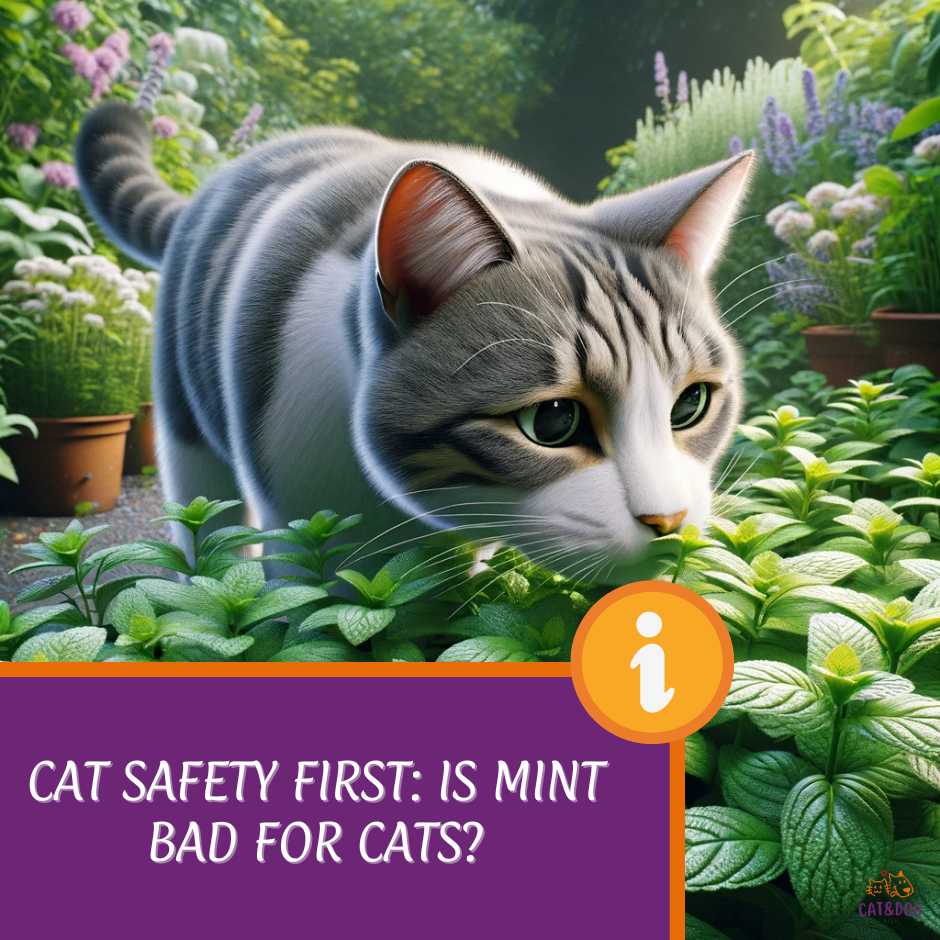Mint is a popular plant often found in household gardens and kitchens; its refreshing flavor enhances a multitude of dishes and beverages.
But if you’re a cat owner, you may have noticed your furry friend taking an interest in this fragrant herb.
Is mint bad for cats? Yes, it can be harmful to cats.
Cats are known for their curiosity, especially about plants, and mint, also known by its scientific name Mentha, is no exception.
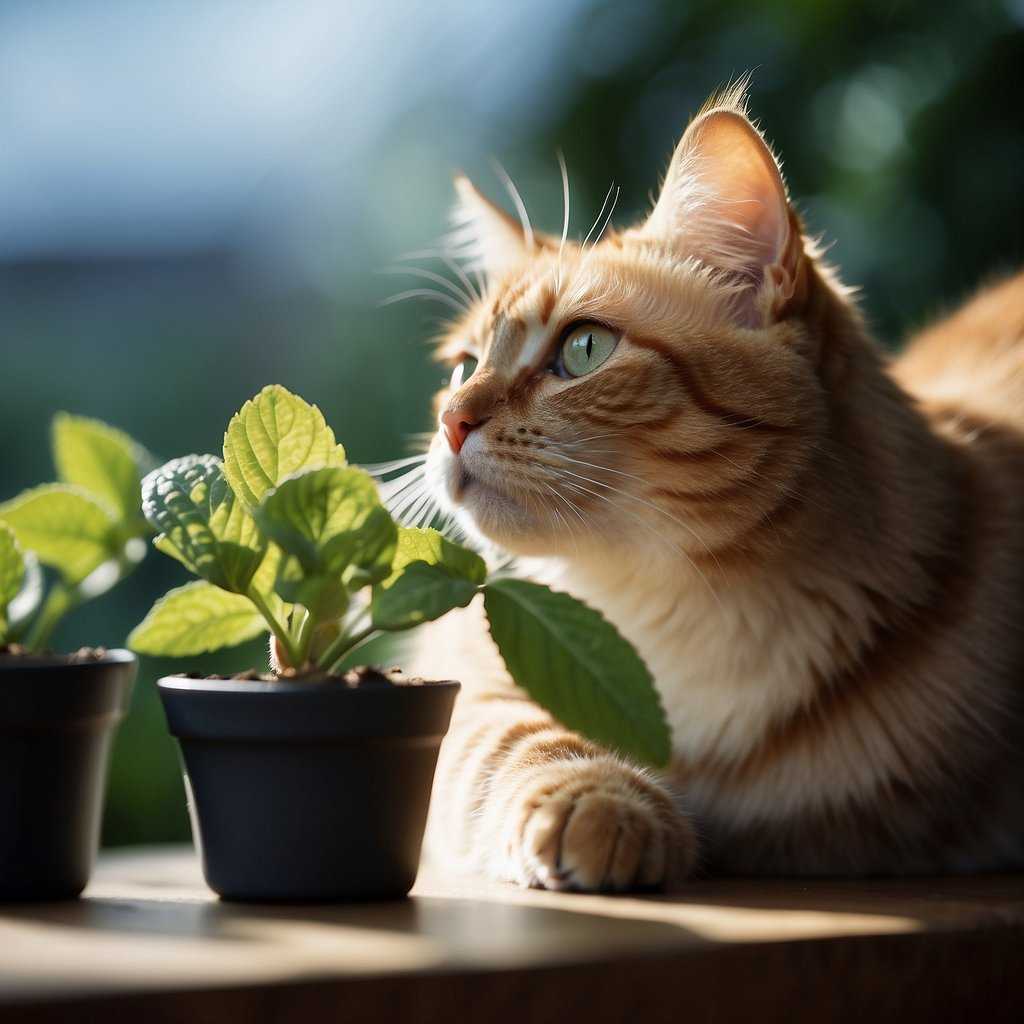
Since mint varieties are vast and some may be within the paw’s reach of your inquisitive companion, it’s important to know which ones are safe and which could cause problems.
Understanding the differences is vital because while catnip, a member of the mint family, is well-known for being cat-friendly, other types of mint may not be as benign.
Given that a nip of some mints could lead to a trip to the vet, let’s ensure your cat’s grazing habits stay on the safe side.
Mint as in the plant? It’s not poisonous to cats. Catnip is part of the mint family. And candy mints may not be good for them, but not poisonous just like any human snacks to cats (though I don’t know of any cat that would eat a candy mint).
Being vigilant about what our cats ingest is crucial, and to ensure their safety, we must always avoid toxic ingredients, including certain varieties of mint that can negatively affect their health.
Key Takeaways
- Catnip is safe for cats, but other mints can be harmful.
- Knowing which varieties of mint are safe can prevent health issues.
- Vigilance in plant choices and cat monitoring can keep your pet healthy.
The Safety of Mint for Cats
Mint is more than just a pleasant aroma for your mojitos; it’s a herb that comes with its own set of nutrition points.
Rich in menthol, the essential oil you often find in your toothpaste, mint certainly sets a tingle on your tongue. But here’s the kicker – while you’re relishing in that cool sensation, it’s a different story for cats.
Fresh mint, which is rich in Vitamins A and C, can be beneficial for humans, supporting healthy bones, skin, and vision, as well as the immune system.
However, it’s important to note that cats have different dietary needs, and certain herbs, including mint, may not be suitable for them.
Have you ever noticed how cats go head over heels for catnip? It’s because catnip and mint are like distant cousins in the plant world.
Cats react to catnip because of nepetalactone, a compound that’s a feline attraction superstar. Mint doesn’t have this, so while you get the “oohs” and “ahhs” freshening your breath, for cats, it’s more of a "meh".
Now, the lowdown on Risks. Mind you, not all mints are born equal in the eyes (or rather, the stomachs) of our kitties:
- Peppermint: More ‘oh no’ than ‘ho ho ho’ for cats.
- Spearmint: Another no-go. Sorry, furballs.
Ingesting these can give your kitty an unwanted bellyache or worse, mess with their nervous system.
Talk about a game of risk that’s not worth the catnip high! Here are the warning flares you should keep an eye out for:
- Upset tummy: Think vomiting or diarrhea. Ugh!
- Wobbly legs: When adventures on the cat tower turn less graceful.
- Mood funk: More Grumpy Cat, less Puss in Boots.
Remember, plants in your garden might be the chemical-free variety, but it’s best to play it safe and keep them out of paw’s reach. Your feline friend may appreciate the gesture with some extra purr-love!
Comprehensive Guide on Is Mint Bad For Cats?
Did you know not all mint is created equal, especially when it comes to our feline friends? Let’s take a catwalk through the garden of mint varieties and see which are friend or foe to your purring pal.
Garden Mint (Mentha spicata) Also known as spearmint, this common garden plant is a no-go. If your kitty nibbles on it, they could experience:
- Vomiting
- Diarrhea
- Gastrointestinal upset
Remember, those potent oils aren’t meant for kitty consumption! However, some oils are safe for your feline friends.
Peppermint (Mentha × Piperita) Ah, the refreshing peppermint! While it’s a treat for us, it’s:
- Unsafe for cats
- Can irritate the skin and respiratory system
Better to keep it in your tea, not in your cat’s reach.
Safe Varieties to Consider:
- Catnip (Nepeta cataria): Safe and loved by many cats, stimulating playfulness and euphoria.
- Catmint (Nepeta species): Often confused with catnip but the American Society for the Prevention of Cruelty to Animals (ASPCA) suggests caution. Be sure to research if it’s the right fit for your pet.
Here’s a quick reference for you:
| Mint Variety | Safe for Cats | Not Safe for Cats |
| Garden Mint (Spearmint) | ✓ | |
| Peppermint | ✓ | |
| Catmint | (Research) | |
| Catnip | ✓ |
A little curious about catmint? It’s a mixed bag, as some varieties might be okay, but others, not so much. When in doubt, play it safe and stick with catnip – tried, true, and cat-approved!
In the end, your cat’s safety comes first, so let’s keep that minty fresh breath for humans, shall we?
Identifying and Managing Mint Poisoning in Cats
Have you ever wondered if that lovely mint plant could harm your feline friend?
While mint adds a refreshing touch to our mojitos, it’s not always safe for cats. Let’s explore the signs and what to do if you suspect mint poisoning in cats.
Symptoms of Mint Poisoning When cats interact with mint, especially certain types like garden mint, they might show several symptoms, indicating they’re not feeling their best. Keep an eye out for:
- Nausea: Unsettled behavior or frequent lip licking could be a clue. (1)
- Vomiting and Diarrhea: These are tell-tale signs that something is off. (2)
- Weakness or Lethargy: If your cat is less active or seems fatigued, it could be a sign of poisoning. (3)
Remember, these symptoms could be indicative of other issues as well, so context matters. If your cat has had access to mint, it’s a red flag.
Treatment and First Aid If you catch your cat snacking on your mint plant:
- Remove Plant Material: Gently check their mouth and clear any remnants of the plant.
- Prevent Further Access: Keep your cat away from the plant to prevent additional consumption.
- Observe: Watch your cat closely for any of the mentioned symptoms.
Above all, if you see these symptoms, don’t wait it out—your furry friend’s health is at stake. A quick trip to the vet can make all the difference.
Your vet can provide the care your cat needs, from decontamination to supportive therapies. Remember, it’s better to be safe than sorry!
By being vigilant and proactive, you can help ensure that your cat stays healthy and happy, even around pesky plants like mint. Keep these tips in mind and you’ll be ready to act swiftly should the need arise.
Preventive Measures and Safe Alternatives
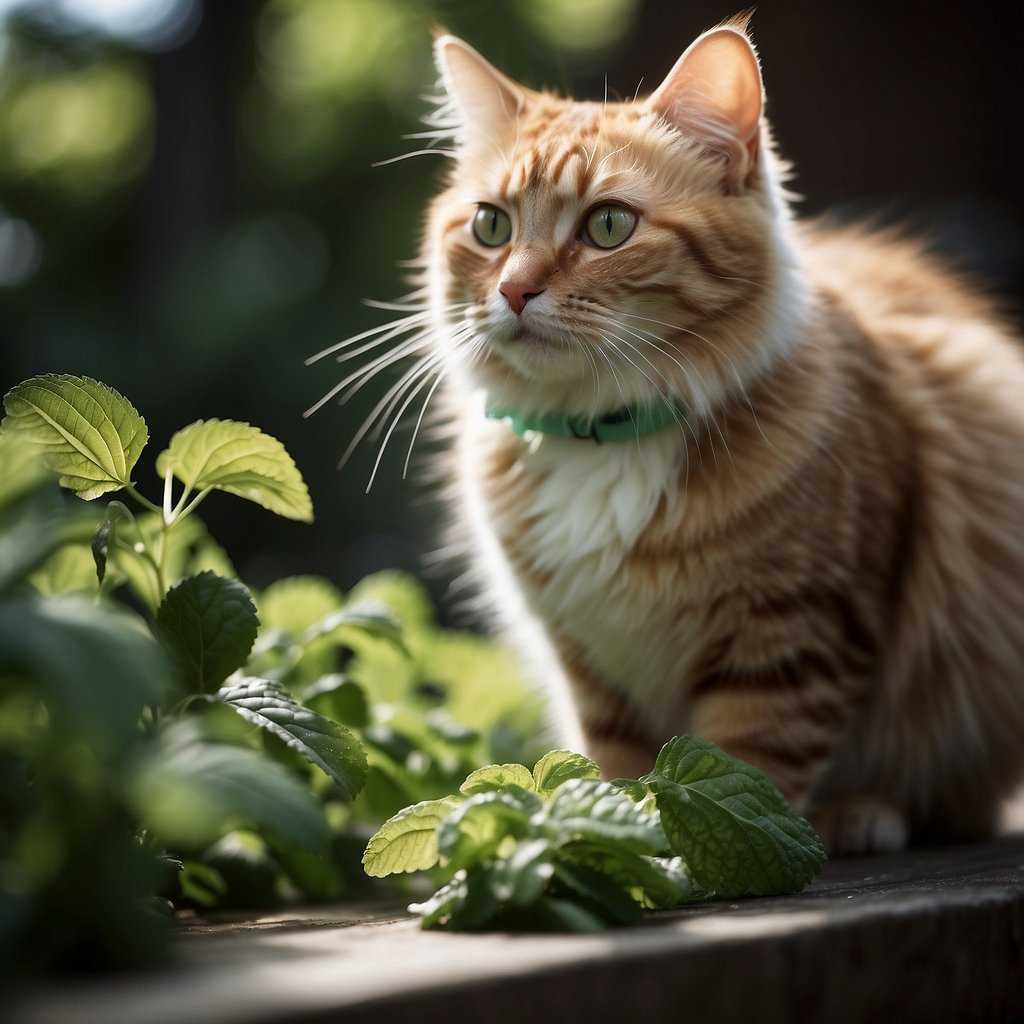
Keeping cats safe around plants can be a bit like herding, well, cats. But don’t fret!
With a few simple tweaks to your green thumb routine, you can cultivate a cat-friendly environment that’ll make both you and your furry pals, pet owners, purr with delight.
Safe Gardening Tips For Cat Owners:
- Placement Matters: Elevate toxic plants out of paw’s reach. Think hanging baskets or high shelves.
- Restrict Access: Consider using cat-proof planters or creating a separate area where your cat can’t explore.
- Knowledge is Power: Always check if a plant is safe before bringing it home. The ASPCA offers a comprehensive list.
Not all Mint is Created Equal: While mint ingestion may add a fresh zing to our mojitos, it’s not always cat-friendly.
Essential oils found in some mint varieties, like peppermint, can be particularly risky, potentially disrupting their digestive and respiratory systems.
But no need to nix all your herby dreams — some mint relatives are big hits with the kitties. Here’s a look:
| Safe Plants | Cautious Plants |
| Cat Grass | Garden Mint |
| Catnip (in moderation) | Peppermint Oil |
Feel like growing a mini oasis for your cat but are worried about their love of leafy snacks? Why not try some Cat Grass? It’s easy to grow and perfectly safe for your cat to nibble on.
And remember, Catnip is the ultimate peace offering in the plant world for cats, just be wary of any allergies. Besides, who doesn’t enjoy watching their cat roll around in euphoria?
Keeping your garden cat safe doesn’t have to be a duel with danger. With these pointers, you’re all set to create a haven that both you and your four-legged garden inspector can enjoy! 🌱😸
Long-Term Effects and Case Studies
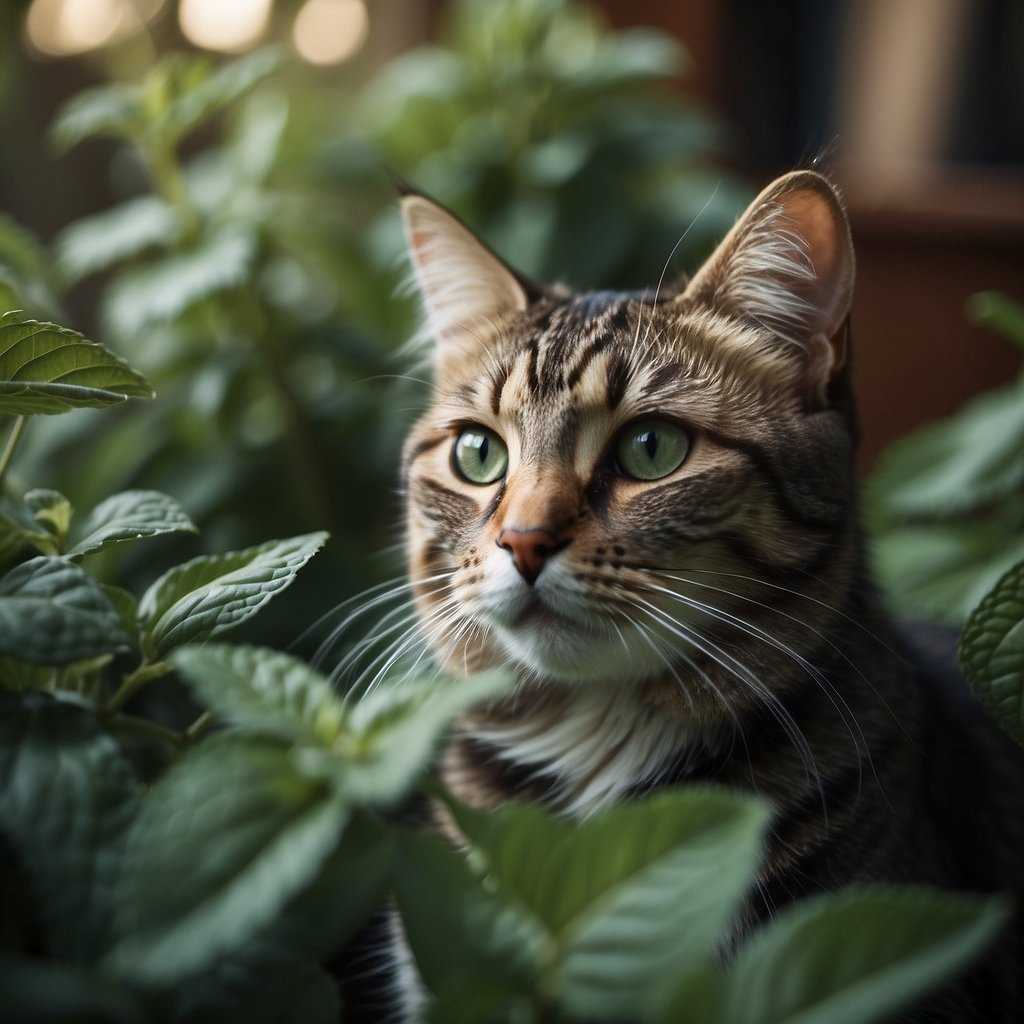
Cats do have a quirky love affair with certain types of mint—think catnip! However, when it comes to the standard garden variety, the safety isn’t as clear-cut.
Chronic Effects: While occasional exposure to some mint varieties may produce short-lived behavioral changes or mild digestive upset, chronic ingestion might present a more significant concern.
Essential oils found in most mint plants can be troublesome. In the long run, you might notice:
- Gastrointestinal issues: Reiterated tummy troubles, anyone? (4)
- Liver complications: Yes, even the liver can take a hit over time. (5)
Real-Life Feline Foes of Mint: Some case studies have reported that when cats repeatedly snack on certain mint plants, especially your common garden mint, the effects can escalate from merely an upset stomach to more severe symptoms such as:
- Lethargy
- Bloating
- Abdominal discomfort
Table 1: Reported Symptoms in Cats With Mint Exposure
| Case | Symptoms Observed | Outcome |
| 1 | Lethargy, Weakness | Monitored; Veterinary Care Needed |
| 2 | Abdominal Discomfort | Improved with Care |
| 3 | Bloating | Required Dietary Changes |
Remember, not all mint is created equal in the eyes (or rather, the nose and mouth) of your cat. Catnip and catmint are usually the party varieties for your kitty—exciting to sniff, and safe in moderation.
But when it comes to other types, like the one that flavors your mojito, it’s better to keep it out of paw’s reach to avoid any long-term effects. Got it?
Always err on the side of caution and let the vet be your guide if Mr. Whiskers decides to go on a mint munching spree.
Now that you know what and how you can safely feed your cat, it’s just as important to find a bowl that supports their health and well-being.
With whisker-friendly bowls and a wide tray to catch any spills, our Hepper NomNom Cat Bowl is our favorite option.
Expert Opinions and Veterinary Advice
Well, let’s see what the experts have to say about cats and mint, shall we?
Mint and Your Cat: What Do Vets Say?
- Most Mints Are a No-Go Common household mint contains essential oils that could irritate your cat’s digestive system, so it is better to avoid the plant and any harmful ingredients to your cat. According to vets, it’s best to err on the side of caution and keep mint away from your curious pet.
- Beware of Poisonous Varieties: Specific types of mint can be toxic to cats. If your cat consumes a large amount of certain mints, poisoning is a real risk.
Safety First: Recognizable Signs
Keep an eye out for these reactions:
- Vomiting
- Diarrhea
- Gastrointestinal upset
If you spot these symptoms, it’s vet visit time!
A Minty Exception?
- Cat-Friendly Variants: Interestingly enough, not all mint is bad. Catnip and catmint, for instance, are loved by most felines. The key is knowing which is which!
Remember This:
- Moderation and Supervision: Even with cat-friendly variants, it’s all about moderation. Don’t let them turn those plants into a salad bar!
In summary, while some plants in the mint family are enjoyable for your cat, most household mints should be kept out of paw’s reach.
No mint cookie sharing with your kitty companion, please! Always consult your veterinarian for the best advice tailored to your cat’s unique needs.
Keep that in mind, and you both will be minty fresh and happy! If you have an indoor cat, it is important to take extra precautions when it comes to houseplants.
Avoid keeping the mint indoors if you have an indoor cat, and opt for non-toxic plants, like wheatgrass, valerian, cat grass, chia grass and parsley plants.
Quick Recap
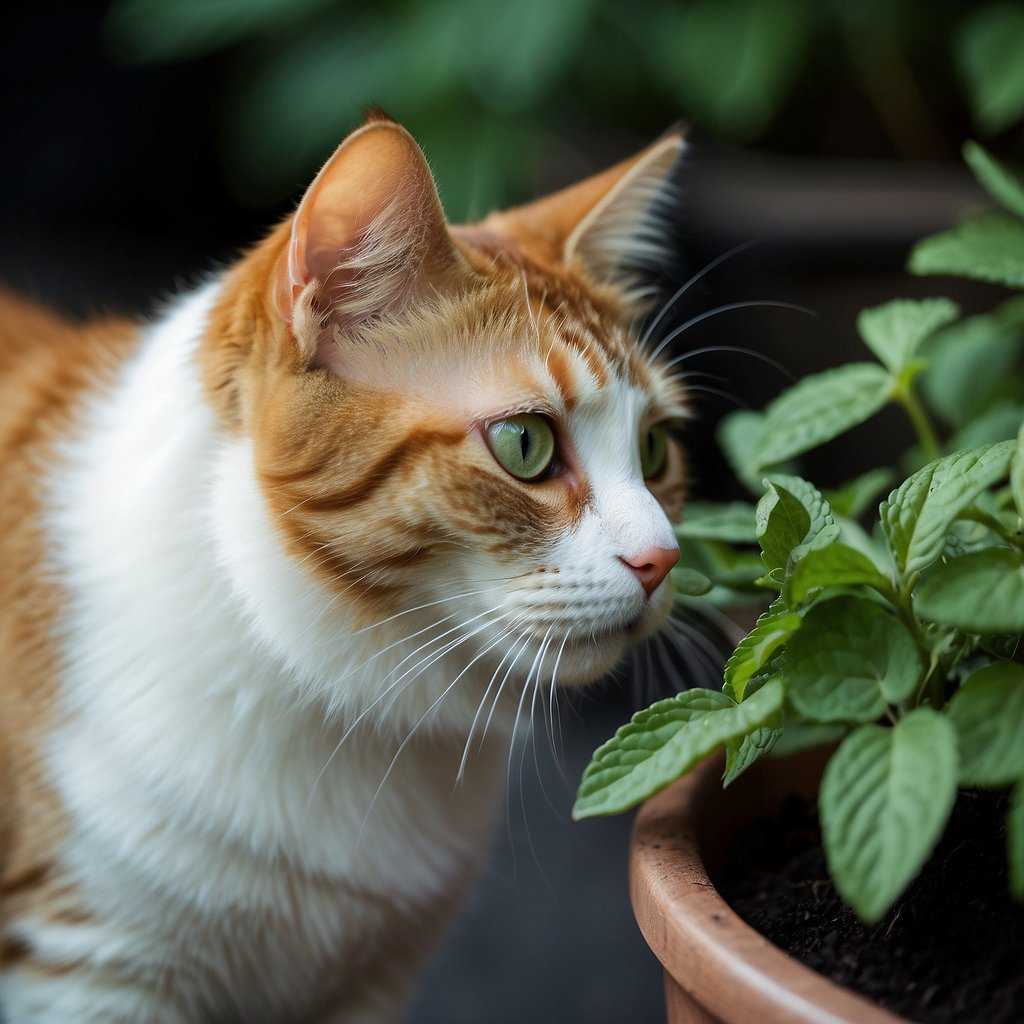
Caught your curious kitty sniffing around your herb garden? You might wonder, “Is it okay for them to nibble on some mint?” Well, let’s break it down!
- Toxicity: First things first, mint (from the genus Mentha) is a no-go for your feline friend. Despite its refreshing scent, it can be harmful to cats. The American Society for the Prevention of Cruelty to Animals (ASPCA) includes mint in the list of plants that could be toxic to your pet.
- Symptoms: If your cat eats mint, look out for signs of mint poisoning. These can include gastrointestinal upset, such as vomiting or diarrhea. However, don’t panic! It usually requires more than just a tiny nibble to cause serious issues.
- Safe Alternatives: Love giving your cat some greenery? Catnip, a relative of mint, is safe and often enjoyed by cats. It can even be a fun treat due to the euphoric effect it has on many kitties!
- Precautions: Keep mint out of paw’s reach and be extra cautious with mint-flavored products and essential oils – these could pose additional risks.
Here’s a friendly reminder: When in doubt, play it safe and consult your vet. They’re the best resource for ensuring the health and happiness of your four-legged companions.
So, while you enjoy your mojitos free of worry, let’s keep the minty freshness away from your cat’s menu. Your furry friend will thank you with purrs and cuddles, minus the tummy troubles! 🐾
Frequently Asked Questions
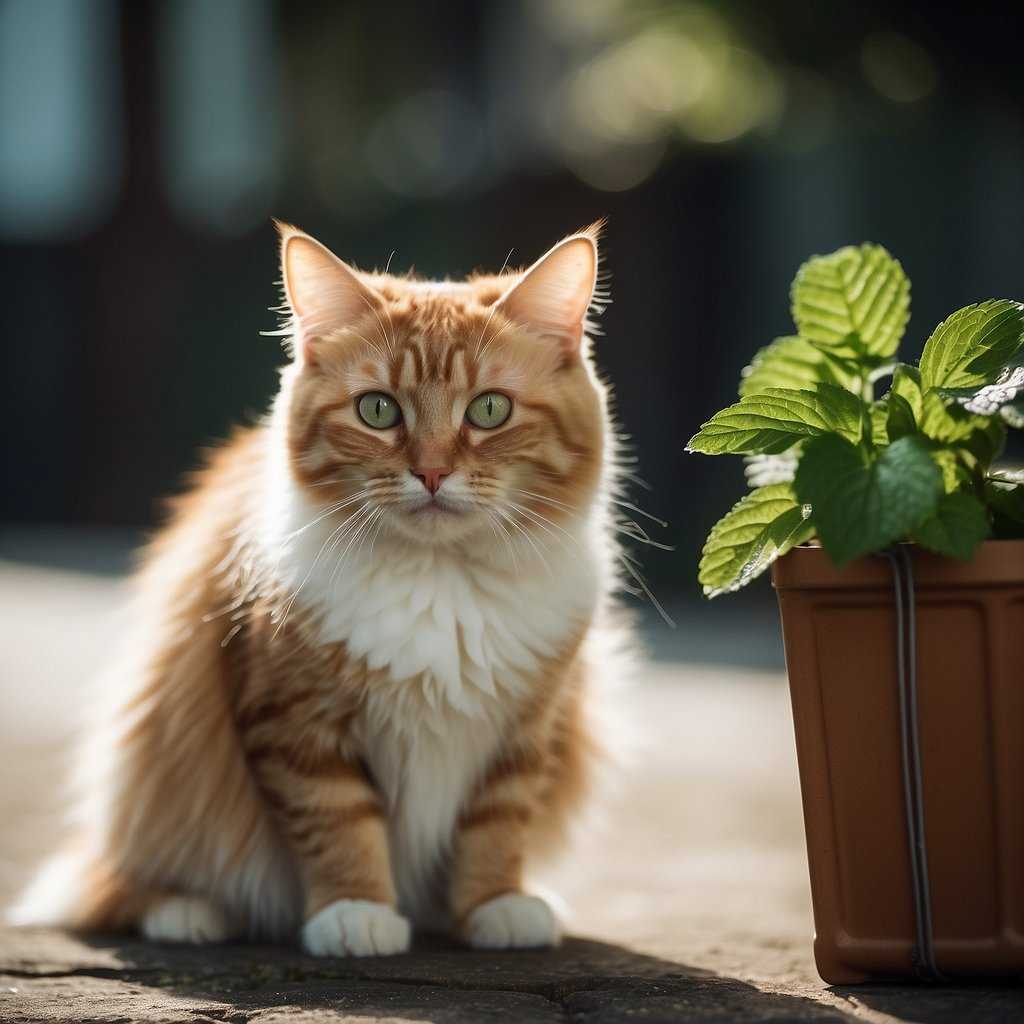
When it comes to your cat’s curiosity about mint, you might have a couple of questions.
We’ve gathered the most common concerns so you can have all the info right at your fingertips. Let’s dive in and keep those whiskers twitching safely!
Safe Varieties of Mint for Cats?
Are you pondering whether some mint varieties are friendlier to your fuzzy companion?
While most mints aren’t recommended, catnip, a member of the mint family, is okay for your cat. It’s not only safe but can be a delightful treat for your furry friend!
What are the effects of my fur baby nibbling on some mint?
If your kitten has been sneaky and snagged a nibble of mint, watch out for symptoms like an upset stomach.
In larger amounts, mint can lead to more severe issues like a drop in heart rate. So, a tiny taste? Probably okay, but let’s not make it a habit.
Can Cats Eat Mint in Small Quantities?
You might wonder if a little mint is okay for your feline. A minuscule amount might not cause any immediate harm, but it’s best to err on the side of caution.
Mint contains essential oils that can be toxic to cats, so it’s smart to avoid giving large amounts of mint to your kitty.
Long-Term Effects of Mint on Cats?
Long-term effects? That’s a no-go zone. Repeated exposure to mint can lead to liver damage or more drastic health issues.
It’s kind of like feeding them candy—might seem fun, but it’s not worth the risk, right?
Does anyone know if a whiff of mint is a no-go zone for kitties?
Just a sniff of mint won’t send your cat into a frenzy, but it’s not their favorite aroma. Cats have sensitive noses, so the strong scent might be overwhelming.
No need to go on a mint-hiding mission, but don’t encourage a mint-sniffing spree either.
Can our feline friends safely enjoy the aroma of spearmint, or should we stash it away?
Spearmint’s scent is intense, and your cat probably won’t be its biggest fan.
While smelling spearmint isn’t as risky as eating it, it’s still a good idea to keep it out of your cat’s interest zone.
Your fur baby will thank you for it with extra purrs and cuddles.
- Where to find the most trustworthy real money casinos - August 7, 2025
- Online Casinos That Approve PayPal: The Ultimate Overview - August 7, 2025

